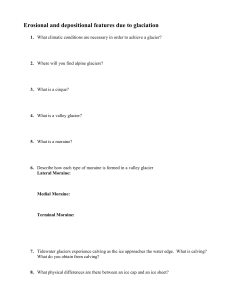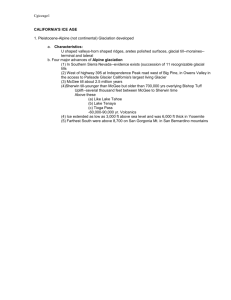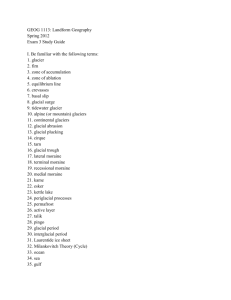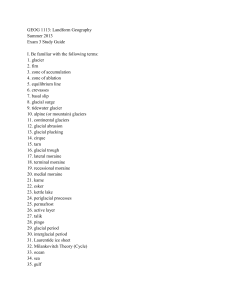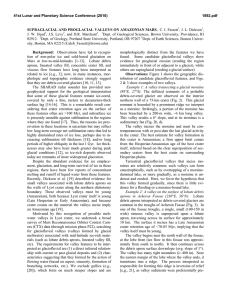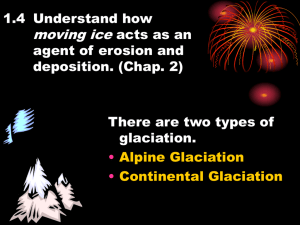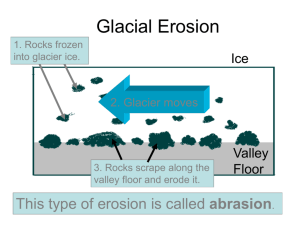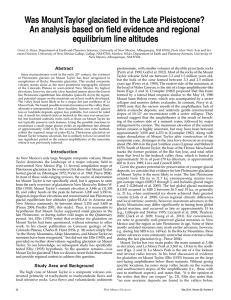Glaciology Worksheet
advertisement
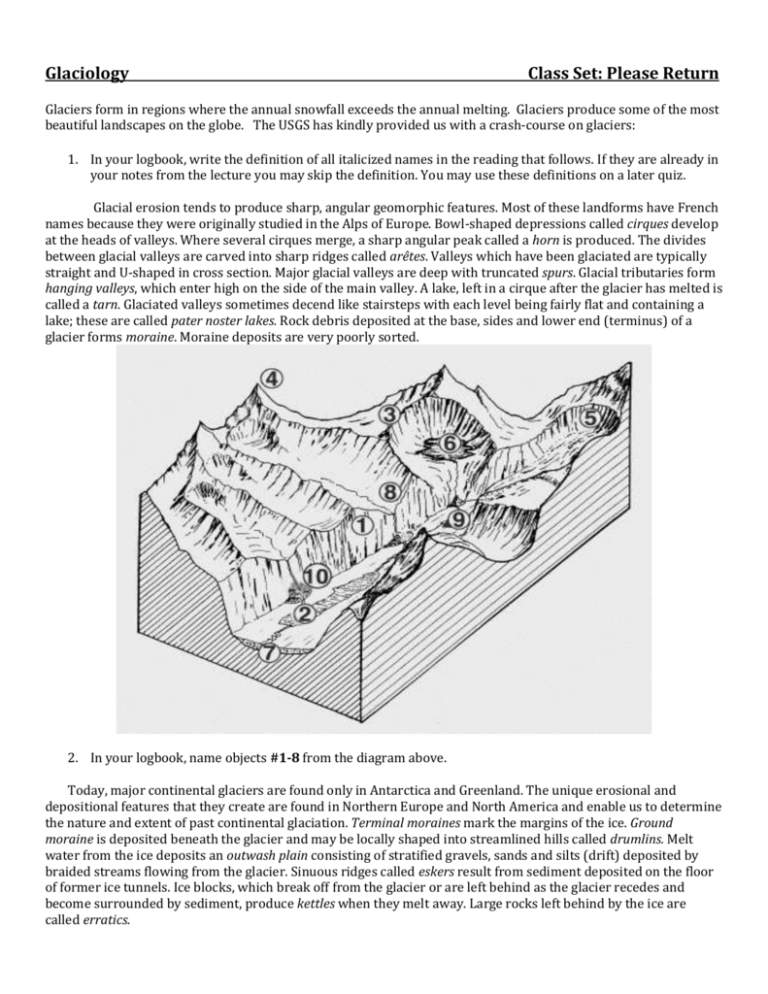
Glaciology Class Set: Please Return Glaciers form in regions where the annual snowfall exceeds the annual melting. Glaciers produce some of the most beautiful landscapes on the globe. The USGS has kindly provided us with a crash-course on glaciers: 1. In your logbook, write the definition of all italicized names in the reading that follows. If they are already in your notes from the lecture you may skip the definition. You may use these definitions on a later quiz. Glacial erosion tends to produce sharp, angular geomorphic features. Most of these landforms have French names because they were originally studied in the Alps of Europe. Bowl-shaped depressions called cirques develop at the heads of valleys. Where several cirques merge, a sharp angular peak called a horn is produced. The divides between glacial valleys are carved into sharp ridges called arêtes. Valleys which have been glaciated are typically straight and U-shaped in cross section. Major glacial valleys are deep with truncated spurs. Glacial tributaries form hanging valleys, which enter high on the side of the main valley. A lake, left in a cirque after the glacier has melted is called a tarn. Glaciated valleys sometimes decend like stairsteps with each level being fairly flat and containing a lake; these are called pater noster lakes. Rock debris deposited at the base, sides and lower end (terminus) of a glacier forms moraine. Moraine deposits are very poorly sorted. 2. In your logbook, name objects #1-8 from the diagram above. Today, major continental glaciers are found only in Antarctica and Greenland. The unique erosional and depositional features that they create are found in Northern Europe and North America and enable us to determine the nature and extent of past continental glaciation. Terminal moraines mark the margins of the ice. Ground moraine is deposited beneath the glacier and may be locally shaped into streamlined hills called drumlins. Melt water from the ice deposits an outwash plain consisting of stratified gravels, sands and silts (drift) deposited by braided streams flowing from the glacier. Sinuous ridges called eskers result from sediment deposited on the floor of former ice tunnels. Ice blocks, which break off from the glacier or are left behind as the glacier recedes and become surrounded by sediment, produce kettles when they melt away. Large rocks left behind by the ice are called erratics. For the next questions, we will focus on the glacial features of Yosemite National Park. Valley of Tenaya Creek, Yosemite National Park Half Dome is on the right and North Dome is on the left. Answer the following questions in your logbook: 3. How would you describe the shape of the profile of this valley? 4. How do you think this profile differs from one of a valley carved entirely by a river? Features of Alpine or Valley Glaciation Alpine glaciers will steepen mountain slopes and deepen the valleys as they erode away the already irregular topography. Figure 5.12 below illustrates the changes that a previously unglaciated mountainous area experiences as an alpine glacier erodes the landscape. Many of the landforms produced by glacial erosion, such as arêtes, cirques, horns, and hanging valleys (Figure 5.13), are identified in Figure 5.12C. Use Figure 5.12 to answer the following questions in your logbook. 5. How has glaciation changed the shape and depth of the main valley? 6. Prior to glaciation, tributary streams were adjusted to the depth of the main valley. What has been the consequence of glacial erosion on the gradients (steepness) of tributary streams? 7. Use your own words to describe how the appearance of the area has changed from what it was prior to glaciation. Using your textbook (starting on page 457), name the following figures given. Note that they are in sequential order. 8. What is figure 17-10 showing? 9. What is figure 17-11 showing and how did it get to New York? 10. How did the feature in Figure 17-13 form? 11. What is featured in the very middle of Figure 17-14? 12. What is shown in Figure 17-17 and how was it created? 13. What does figure 17-21 show? 14. What two types of moraines are shown in Figure 17-25? Refer to page 476 in your textbook: 15. Read the section labeled Causes of Glaciation. Explain at least two of the explanations for glaciation as given in the textbook. Be specific in your answers. In your logbook, do your best to sketch the above image making note of prominent geological features. Label the following terms on your sketch using your Geology Textbook and notes as necessary. See page 452 in your textbook. Arete Medial Moraine Terminal Moraine Zone of Wastage Hanging Valley Outwash Fan Terminus Cirque Horn Outwash Plain Truncated Spur Lateral Moraine Zone of Accumulation U-Shaped Valley



